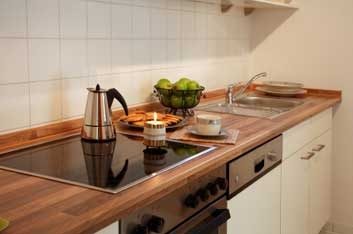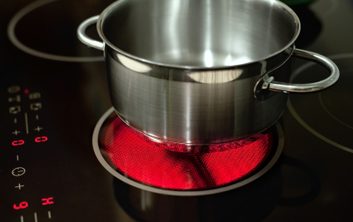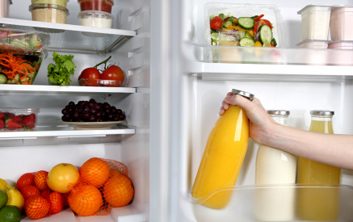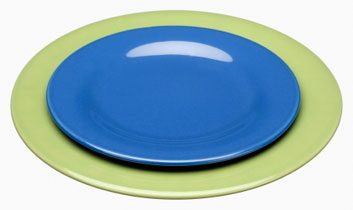
Slim down your kitchen
If you’re hoping to shed pounds, you’ve likely fantasized about a padlock on the pantry or tossing out the kids’ snacks for good. No wonder: According to Brian Wansink, author of Mindless Eating: Why We Eat More Than We Think, we’re faced with more than 200 food-related decisions each day. So willpower alone may not be enough. “Everything around us, from the cookies we just baked to an ad, tells us to eat,” Wansink says. The good news is, you can fight back. Try these eight tips for a healthier, weight-loss-friendly kitchen.

1. Clear the clutter
Use counters for food preparation only, not storage (so no cookie jar), advises Peter Walsh, author of Does This Clutter Make My Butt Look Fat? He takes a hard line when it comes to visual distractions: “Most kitchens are littered with gadgets, but you can’t make your healthiest food choices in a cluttered, disorganized space. You wouldn’t eat in a messy restaurant, would you?”

2. Keep snacks out of reach
Stash snacks on the top shelf of cabinets, and keep second helpings off the table. “When you have to inconvenience yourself, it gives you pause to ask, ‘Do ?I really want this?’?” says Wansink. In a Cornell University study, researchers found that when office assistants had a jar of small chocolates on their desks, they ate nine per day; when the jar was moved out of reach, they ate four.

3. Stock up your spice rack
Here’s a great reason to refresh and expand your herb and spice collection: According to a study from Chicago’s Smell & Taste Treatment and Research Foundation, boosting the flavour of food could contribute to weight loss. The study’s author, Dr. Alan Hirsch, explains that seasoning low-calorie foods, sniffing the food before you eat it and chewing for longer than usual may make you feel full sooner-and eat fewer calories.

4. Try a new cooktop
When it comes to making healthy meal choices, every second counts. But that doesn’t mean relying on so-called convenience food. In fact, a University of California study showed that homes favouring prepackaged foods didn’t get meals on the table any faster. To speed ?up home cooking, consider a new induction cooktop, available from most major appliance brands, which uses electromagnetic energy to heat pans and boil water in half the time of gas or electric stoves.

5. Choose your glasses wisely
Avoid overindulging by using short, wide glasses for liquids you want to drink more of, like water or skim milk, and tall, narrow glasses for higher-calorie beverages, such as juice, pop or beer. Cornell University researchers found that people poured more juice into a short, wide glass than a tall, narrow one-but perceived the opposite.

6. Downsize your fridge
If you own a monster fridge, make less room for unnecessary food by using a shelf to store drinking glasses. “If we have the space, we’ll fill it-and usually not with the most nutritious choices,” says Walsh. With many refrigerators providing 20 cubic feet (0.6 cubic metres) or more, it’s no wonder we’re jamming the shelves with processed foods we don’t need. And big fridges may help contribute to big bottoms. According to Appliance Magazine, the bestselling fridge at one U.K. appliance retailer in 2008 was 20 percent larger than the bestseller in 2001. (Perhaps there’s a connection between that and the tripling of obesity rates among adults in England over the past 20 years.) If you’re in the market for a new refrigerator, consider a smaller counter-depth model.

7. Grab a small plate
In Mindless Eating, Wansink says one of ?the secrets to eating more healthfully is to become an illusionist. We tend to serve ourselves more when we use big plates because they make the food look small. But when we use smaller plates, we perceive that we’re getting more food. “If you take a medium-sized hamburger and serve it to a person on ?a saucer, they estimate it as having 18 percent more calories than if you serve it to them on a normal-sized plate,” he writes. So, drop off those dinner “platters” at a charity and trick yourself by using salad- or lunch-size plates at mealtimes instead.

8. Turn off the TV
Don’t let television dictate when you eat. Statistics Canada numbers show that 25 ?percent of men and women who reported watching 21 hours or more of television per week are classified as obese. In a study, Wansink and his colleagues at the Cornell Food and Brand Lab found that Parisians, who listened to internal cues ( “I’m no longer hungry”), tended to have a lower body mass index than Chicagoans, who relied on external cues ( “My TV show is over”). So replace the dining area television with a laptop-also great for looking up healthy recipes.
Related:
• How mindful eating can help you lose weight
• 17 unusual weight-loss tips
• 5 kitchen gadgets that can help you lose weight
